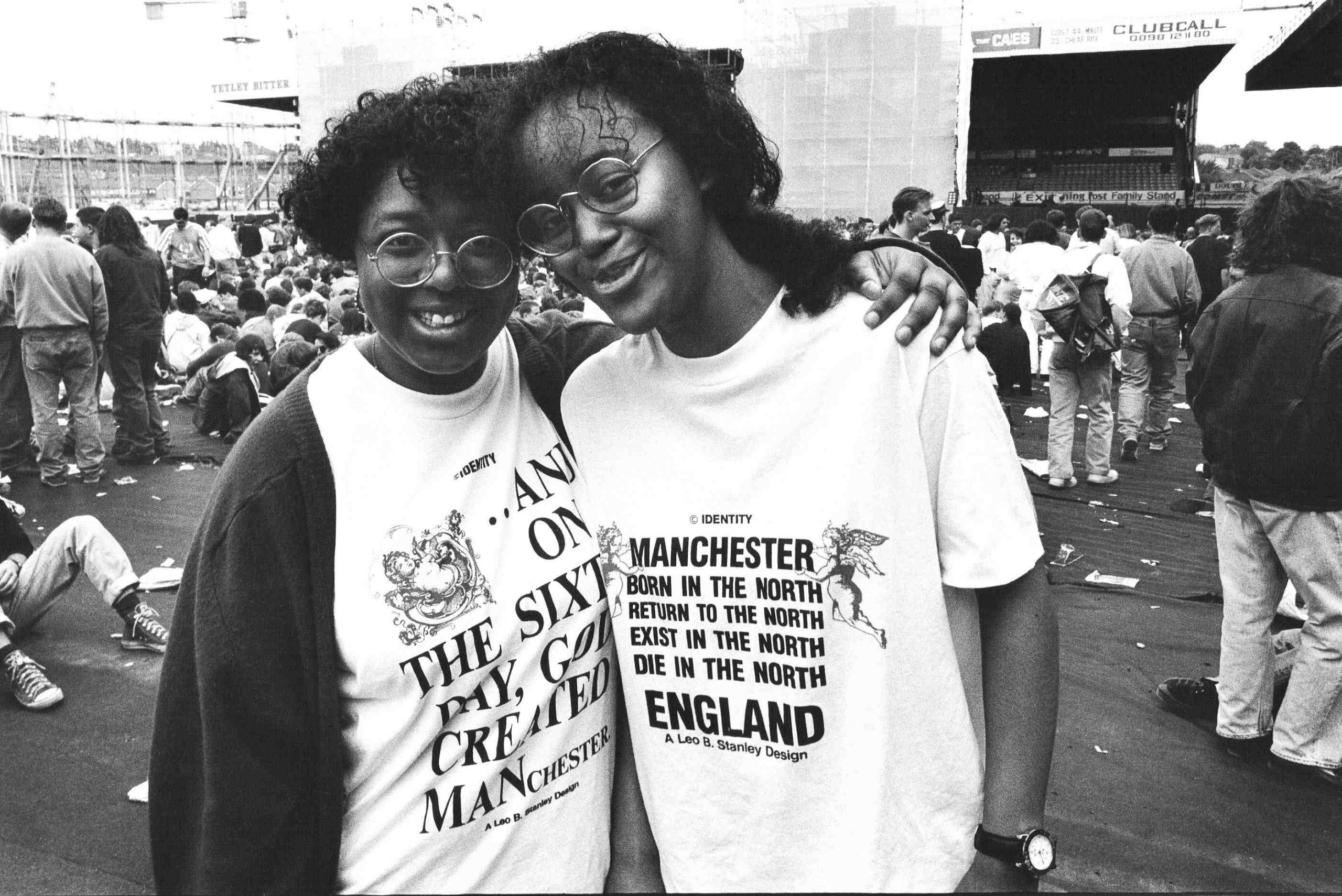Gritty photos celebrating the Madchester years
- Text by Miss Rosen
- Photography by Richard Davis

As the 1980s came to a close, photographer Richard Davis remembers a seismic cultural shift taking place in the UK with the rise of acid house and rave parties. “The Tory establishment tried their hardest to clamp down, but change was coming – particularly among the young and the working class,” he says. “Thatcher was on the way out and it felt like this was our payback.”
A new decade began with a wave of freedom and hope. The Berlin Wall came down, Nelson Mandela was released from prison, and the Poll Tax Riots shook the UK. “There was a positivity in the air,” says Davis, who had moved to Manchester in 1988 at age 22 to study photography.

Zonya & Andrea at Elland Road, Leeds 1991
“The city had that romantic feel, and was politically so much better than the South,” he says. “Straight away, I got used to Manchester and its strong and confident defiant outlook. The city knew it was special and didn’t hide that fact. I like its anti-London stance, which I never ever experienced in the years living in Birmingham. Manchester wanted to be better than London and it offered opportunity.”
Long before occupying a squat in Hulme, Davis had long been a fan of the city’s post-punk scene. “The Kevin Cummins photo of Joy Division on the snowy bridge in Hulme back in 1979 was a major influence on how I looked at the possibilities of photography,” he says.

Afflecks Palace, Manchester 1991

Stone Roses, Wolverhampton 1990
Now, in the new book, The Madchester Years 1989-1991 (Café Royal Books), Davis revisits this fabled chapter of Northern life. Featuring photos of bands including 808 State, Happy Mondays, and Stone Roses, as well as writer Caroline Aherne, poet John Cooper Clarke, and comedian Steve Coogan, Davis captures the city’s flourishing creative scene.
“I always felt I was in the right place at the right time when I’ve looked back,” he says. “Manchester was just about to go crazy, and I with my passion for photography and adventure was ready.”
On his first weekend in Manchester, Davis became friends with a Hulme-based music band, which gave him entry into the scene. “There weren’t many photographers in Manchester at the time so word got around pretty quickly,” he says.

Graffiti, Hulme, Manchester 1989
Soon enough, Davis was photographing it all: the musicians, poets, writers, artists, designers, and comedians who put the “mad” in the mix. Taking inspiration from the wealth of talent at every turn, Davis became deeply motivated to pursue photography.
“All money went to photography, which was massively important as I didn’t have much to start with,” says Davis, who operated a darkroom and studio out of his Charles Barry Crescent squat.
“Living in the outlaw district of Hulme also helped. Those conditions drove me to make more photographs and commit to all the hours spent developing and printing them. I didn’t sleep a lot in those days because there was so much going on. Manchester seemed to have a can-do attitude with no fear of failure.”

Kermit from Ruthless Rap Assassins, Manchester 1990

Caroline Ahearne, Hulme, Manchester 1991

Terry Christian, Manchester, 1991
The Madchester Years 1989-1991 is out now on Café Royal Books.
Enjoyed this article? Like Huck on Facebook or follow us on Twitter and Instagram.
Latest on Huck

Plestia Alaqad: “Journalists should focus on humanising people”
Huck’s April interview — Having become one of the most crucial and followed voices from inside Gaza in the aftermath of October 7, the award-winning author and journalist is releasing a new memoir, ‘The Eyes of Gaza’, collating diary entries made over the past 18 months. We caught up with her to hear more about it.
Written by: Isaac Muk

The instrument makers taking DIY music to a whole new level
What does it take to construct a modular synth? How do you turn a block of wood into a double bass? Here, four craftspeople explain why they chose to rip up the rulebooks and build their own music-making machines.
Written by: Daniel Dylan Wray

Southbank Centre reveals new series dedicated to East and Southeast Asian arts
ESEA Encounters — Taking place between 17-20 July, there will be a live concert from YMO’s Haruomi Hosono, as well as discussions around Asian literature, stage productions, and a pop-up Japanese Yokimono summer market.
Written by: Zahra Onsori

In 1971, Pink Narcissus redefined queer eroticism
Camp classic — A new restoration of James Bidgood’s cult film is showing in US theatres this spring. We revisit its boundary pushing aesthetics, as well as its enduring legacy.
Written by: Miss Rosen

As amapiano goes global, where does it leave its roots?
Rainbow grooves — Over the past decade, the house music subgenre has exploded into a worldwide phenomenon. Jak Hutchcraft went to its birthplace of Mamelodi, South Africa, to explore its still-thriving local scene.
Written by: Jak Hutchcraft

Clubbing is good for your health, according to neuroscientists
We Become One — A new documentary explores the positive effects that dance music and shared musical experiences can have on the human brain.
Written by: Zahra Onsori